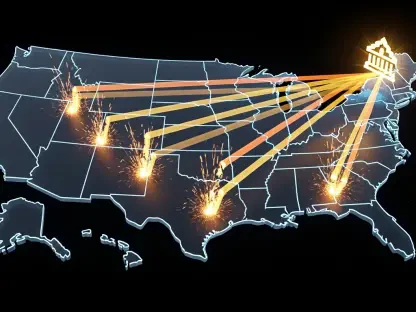In recent years, the TSA’s deployment of facial recognition technology at major U.S. airports has sparked significant debate. Promoted as a means to boost security while enhancing the travel experience, this technology presents a quandary for travelers concerned about privacy and personal liberty. As airports increasingly adopt biometric methods, a deeper understanding of its implications becomes crucial. This discussion examines whether travelers should embrace or decline participation in TSA’s facial recognition programs, unraveling a complex tapestry of efficiency claims, privacy issues, and broader societal implications.
The Rise of Biometrics in Aviation
Efficiency and Security Claims
TSA’s endorsement of facial recognition technology stems from its potential to enhance efficiency at security checkpoints. By automating the identity verification process, TSA aims to not only expedite lines but also strengthen security measures. This biometric approach theoretically decreases human error, providing a seamless travel experience and potentially reducing waiting times. Proponents further assert that automated systems can more effectively detect potential threats, firmly planting the technology as a key asset in modernizing airport security protocols. However, skepticism remains prevalent among some quarters regarding the actual improvements in security versus traditional methods.
Nevertheless, the introduction of facial recognition into aviation raises questions about tangible benefits when juxtaposed with inherent risks. Efficiency is undeniably a valuable goal in high-traffic environments like airports, but it should not overshadow vital concerns such as data privacy and user consent. The push for rapid adoption, driven largely by the perceived convenience, fuels discussions about striking the right balance. As these biometric solutions are implemented, public dialogue often highlights the contrast between technological advancements and the preservation of fundamental civil liberties.
Privacy Concerns
The integration of facial recognition technology into TSA’s protocols ignites a slew of privacy concerns among travelers and privacy advocates alike. While these systems might promise streamlined processes, their reliance on biometric data inevitably sparks apprehension regarding constant surveillance and potential misuse of personal information. The notion of being continuously monitored as one moves through airport spaces raises alarms about the extent to which individual privacy might be compromised. Advocates argue that while technological efficiency is important, it should not come at the cost of travelers’ rights to personal autonomy and confidentiality of their biometric data.
Further complicating this issue is the lack of robust regulations governing the collection, storage, and sharing of biometric information. Privacy watchdogs highlight potential vulnerabilities inherent in these systems, such as data breaches and unauthorized use of stored images, amplifying concerns over whether adequate safeguards are in place. Without comprehensive transparency and clear communication, travelers remain skeptical about the true impact of facial recognition technology on their privacy. These factors underscore the critical need for rigorous oversight and accountability measures to ensure the technology serves its intended purpose without infringing on individual freedoms.
Opting Out as a Choice
Travelers’ Autonomy
While TSA assures travelers that participation in its facial recognition program remains optional for U.S. citizens on domestic flights, the reality is less straightforward. Many travelers are unaware of their right to opt out, often due to insufficient communication from airport authorities. This ambiguity obscures the autonomy that individuals should possess in choosing whether to engage with these systems. Ensuring travelers understand how to navigate this choice, without facing undue hurdles, is critical for maintaining user trust and respecting personal preferences regarding biometric data usage.
The onus falls on TSA and airport authorities to make opting out a more transparent process, offering clear pathways for those who choose not to partake in facial recognition scanning. Addressing concerns of autonomy begins with enhancing signage, distributing informative materials, and ensuring that staff are well-equipped to handle queries about opting out. By fostering a more informed travel environment, individuals can make empowered choices aligned with their comfort levels regarding new technology implementations. Without these efforts, opting out may remain an abstract concept rather than an accessible option for many passengers.
Communication and Awareness
An essential element in navigating the complexities of TSA’s facial recognition deployment is effective communication. Much of the current discontent among travelers stems from a lack of adequate information about their rights and the implications of participating in biometric programs. Insufficient signage and vague announcements contribute to a general lack of awareness, leaving travelers ill-equipped to make informed decisions. When consent is muddled or implied rather than explicitly requested, it erodes the foundation of trust necessary for the smooth integration of new technologies within public spaces.
Building a framework where clear communication is prioritized involves enhancing visibility and accessibility of information related to biometric consent and opt-out processes. This includes multilingual resources, prominent displays at checkpoints, and proactive engagement from airport personnel to address passenger concerns as they arise. Educating travelers not only on their rights but also on how biometric data is handled can demystify the process, aligning with the broader goal of transparency. For TSA, fostering an environment of openness and understanding is pivotal to regaining public confidence and ensuring that technological advances are embraced rather than resisted.
Governmental Transparency and Oversight
Storing Biometric Data
One of the prominent issues surrounding the use of facial recognition technology is the ambiguity related to the handling of biometric data collected by TSA. Concerns about what happens to these images after they are captured are widespread, with many questioning the duration for which data is stored and the ways it might be utilized. This lack of transparency contributes significantly to public distrust, as travelers remain wary of potential misuse or unauthorized sharing of their personal information beyond the immediate scope of security verification.
Experts and privacy advocates emphasize the necessity for clear guidelines detailing data retention and handling practices. Guidelines should explicitly define how long biometric data is stored, who has access to it, and under what circumstances it can be used. Bridging these informational gaps is crucial for assuaging fears and enhancing accountability within governmental frameworks. By instituting rigorous data protection protocols and fostering open dialogue, TSA can address these anxieties while reinforcing the legitimacy of its security initiatives. Moreover, establishing a clear stance on data utility can help prevent the proliferation of misconceptions that often fuel resistance to technology adoption.
Oversight and Accountability
The effectiveness of biometric technology deployment hinges significantly on the presence of robust oversight mechanisms. However, the recent dismantling of key oversight entities, such as the Privacy and Civil Liberties Oversight Board, has raised alarms about the diminished ability to monitor and regulate these processes. The absence of independent review bodies contributes to a climate of uncertainty, where accountability may be compromised, and travelers’ rights could be at risk of infringement. Reinstating these entities or developing new ones is imperative for ensuring rigorous evaluation of biometric protocols and maintaining public confidence in their implementation.
Accountability frameworks must be designed to operate transparently, with a focus on monitoring compliance with established data protection regulations. Periodic audits, stakeholder consultations, and public reporting can contribute to a more structured approach in assessing the real-world impact of biometric technologies. Without these measures, the risk of potential overreach in governmental surveillance capabilities remains a potent concern. Reinforcing oversight not only strengthens the ethical deployment of facial recognition technology but also reaffirms the commitment to safeguarding civil liberties and privacy rights amidst evolving security landscapes.
Balancing Security and Privacy
Public Perception
Public perception around the use of facial recognition technology by TSA is often colored by a deep-seated suspicion of government surveillance. Historical missteps in privacy protection amplify these concerns, fostering a climate of distrust that complicates efforts to introduce biometric solutions as standard security measures. The uneasy equilibrium between advancing security procedures and maintaining personal privacy is emblematic of broader societal debates on technological innovation versus fundamental rights. As past experiences shape current attitudes, addressing these concerns requires not only transparency but also active engagement with skeptics.
Efforts to shift public perception must involve acknowledging legitimate privacy concerns and actively working to rectify past oversights. Government entities should articulate clear, evidence-based narratives demonstrating the tangible benefits of biometric technology while adhering to strict privacy commitments. Enhancing public understanding of the safeguards in place fosters a more informed dialogue, bridging the gap between perceived intrusion and genuine security enhancement. By fostering trust through consistent, honest communication, TSA and related agencies can gradually reshape the narrative and promote a more accommodating view of technology’s role in public security efforts.
The Role of Consent
Consent stands at the heart of debates surrounding biometric technology in aviation, serving as a critical component in balancing security needs with individual rights. True informed consent requires that travelers are fully aware of how their biometric data will be used, stored, and potentially shared. Ensuring that individuals can easily opt out without facing barriers or repercussions solidifies the respect for personal agency and aligns with broader privacy rights advocacy. For consent to be meaningful, travelers must receive comprehensive information upfront, without having to seek out complex or obscure processes.
Empowering travelers entails creating an environment where informed choices are respected and facilitated rather than hindered. Engaging with travelers to understand their concerns and incorporating feedback into policy changes can foster a culture of inclusion and respect. By prioritizing a consent-driven approach, TSA and other agencies can effectively demonstrate their commitment to individual privacy, thus fostering a more cooperative atmosphere. Through collaborative efforts, balancing security measures with privacy rights becomes an achievable goal, ensuring that public acceptance aligns with strategic objectives in advancing aviation technology.
Advocacy for Policy Change
Demand for Greater Transparency
The push for greater transparency in TSA’s use of facial recognition technology is growing louder, driven by advocates calling for enhanced policies on data protection and privacy. Clearer communication not only facilitates understanding but also helps to build trust between TSA and the public. By demonstrating how their data will be used and protected, TSA can alleviate some of the skepticism surrounding its initiatives. Strengthened transparency measures are vital for achieving broader acceptance and enhancing the legitimacy of the agency’s efforts to modernize security protocols.
Integrating transparent practices necessitates revisiting and revising existing guidelines to align with evolving expectations regarding privacy protections. Policy revisions should aim to address the specific concerns expressed by travelers, ensuring that the processes related to biometric data collection, storage, and usage are crystal clear. By proactively engaging with stakeholders, TSA can foster a collaborative atmosphere that enhances both privacy protections and the overall effectiveness of its security measures. In doing so, the agency can mitigate resistance and promote a more unified approach to embracing technological innovations.
Strengthening Privacy Rights
In recent times, TSA’s introduction of facial recognition technology at major U.S. airports has stirred considerable controversy. Championed as a method to enhance security while simultaneously improving the travel experience, it presents a dilemma for travelers wary of their privacy and personal freedoms. As more airports begin to employ biometric identification methods, fully grasping the implications of this shift becomes increasingly important. This discussion seeks to explore whether travelers should accept or opt out of TSA’s facial recognition systems by unraveling the intricate web of efficiency claims, privacy concerns, and the broader effects on society. On one hand, proponents argue these systems streamline processes and prevent security threats. On the flipside, critics worry about the erosion of privacy and the potential for abuse or misuse of personal data. As this debate continues, travelers must decide whether the convenience outweighs potential risks to privacy and autonomy.









